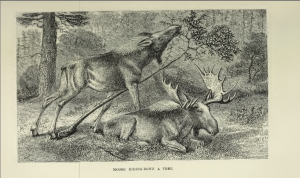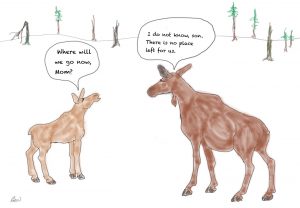A document that sat “in a filing cabinet for almost 40 years” has come to light recently, and reveals the historic concern about protecting mainland moose and more broadly, our “last interior wilderness” in SW Nova Scotia. View post by Bev Wigney on Annapolis Royal & Area – Environment & Ecology (Public Facebook Group), or here
WestFor has finally made a statement responding to public concern about moose.
View Forest harvest and mainland moose in Digby County, NS, posted on SestFor website yesterday (Dec 14, 2020). It begins
Contrary to recent media reports, the preservation of an iconic species like the mainland moose is very important to us. The planned and on-going harvest in Digby County, like all of our harvests, receives approval based on compliance to provincial Mainland Moose Special Management Practices and all other block approval requirements.
So the buck is passed back to the Liberal Government, which remains silent on the issue; shades of the Liberal Government’s initial response to Danny George’s concern about cutting of old growth yellow birch in eastern NS.
I sent this message to WestFor yesterday: “I read your moose news statement. Given the importance you attach to moose, I assume you have an organized system for recording and reporting occurrence of moose on all lands accessed by WestFor members. Can you make that system public, and the results? That would lend some credibility to your assertions. Thx”
Shanni B also wrote WestFor, noting “Your statement is grossly disingenuous. You are misleading the public. There a number of things for which the record needs to be set straight” which she sets out to do with clarity and detail.
Surely it is time for The Premier/cabinet to ask and authorize directly the wildlife experts in L&F to hold a news conference with Q&A and address public concerns openly and honestly.
If not for the sake of of the moose, for the sake of Nova Scotians.
Some Reflections
The legacy of Nova Scotia’s Tobeatic wilderness
Alain Belleveau on NSFN, October 22, 2017
Raising forests, a poem by shalan joudry
Shalan Joudry in the Nova Scotia Advocate
we are not the first generation to lose forests
as trees were slain for ships and forts
l’nu hunters were refused entry to their territory
fracturing livelihoods and continuityin this landscape there have been many ends of the world
as one knows it
parents mourned children at the edges of cliffs
guardians became chained to bottlesto know the stories
as story carriers do
is to constantly taste scars where the wounds
had long punctured throughpeople already devastated by massacres of forests
each new generation’s lost battle to save trees
too many centuries of someone’s world in pieceslet’s tend to the forests like prophets
encourage them to wilder in old growth
and watch them mature into being
 From Forest Life in Acadie
From Forest Life in Acadie
By Capt Campbell Hardy
NEW YORK D. APPLETON & CO., GRAND STREET, 1869. Available on the Internet Archive
The true character of the American forest is not to be studied from the road-side or along the edges of the cleared lands. To read its mysteries aright, we must plunge into its depths and live under its shelter through all the phases of the seasons, leaving far behind the sound of the settlers axe and the tinkling of his cattle-bells. The strange feelings of pleasure attached to a life in the majestic solitudes of the pine forests of North America cannot be attained by a merely marginal acquaintance.
There are some wonderful, insightful descriptions of moose in this classic, with many references to Nova Scotia. A sample:
The presence of the moose is so difficult to detect, except by tracks and signs of browsing, that habitual silence and caution in walking through the forest be- comes a leading trait in the moose hunter, whose eyes are ever glancing around through the forest.
…In November, the rutting season over, the bull moose again seeks the water and recovers his appetite, remaining, nevertheless, in poor condition throughout the winter. He may be now seen standing listless and motionless for hours together, and seeming to take but little notice of the approach of danger unless his nostrils are invaded by the scent of a human being, which will start a moose under any circumstances.
About this time the cows, young bulls, and calves congregate in small parties of three to half a dozen, and affect open barrens and hill sides, where there is a plentiful supply of young wood of deciduous trees, constituting what is termed a “moose-yard.”
If undisturbed they will remain on such spots, feeding round in an area more or less limited in extent, for several weeks ; when, the supply of pro- vender failing, they break up camp and proceed in search of fresh ground. When the weather and state of the snow permits, these shifts are practised throughout the winter.
In Canada, however, and in Northern New Brunswick, the moose is a far less migratory animal than he is in Nova Scotia, owing to the great depth of the snow ; once he chooses his yard he has to remain in it, and is quite at the mercy of the hunter who may have discovered the locality, and who can invade his domains at any time and at his own convenience.
The old bulls become very solitary in their habits, and, indeed, seem to avoid the society of their species, living in the roughest and most inaccessible districts, on hill sides strewn in the wildest confusion with bleached granite boulders, and windfalls where some forest fire has passed over and left the land thus desolate.

